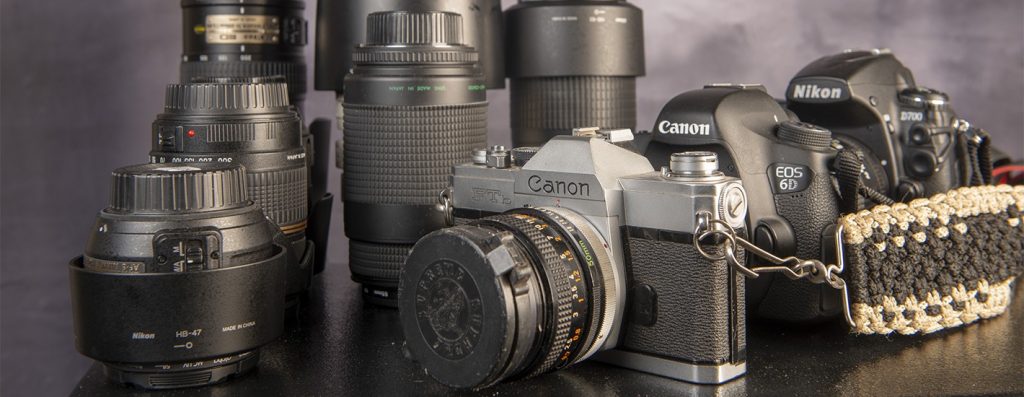
Photography darkrooms have long been considered a relic of the past. With the rapid-fire growth of camera technology favoring digital prints and work spaces, the workshop of yore has been in decline. And after this semester, RCTC’s will be no more as the program ushers in a slate of new changes for the Photography Certificate.

It’s a big change for those who have enjoyed the smell of darkroom chemicals.
“I come completely from an arts background,” photography instructor Brian Steele said. “At the University of Arizona, it was OK to light your negative on fire, throw it on the ground, stomp on it, and then print it, just to see what would happen. Or people would make sculptures out of their photographs or whatever.
“Recently I’ve realized what I fell in love with for photography is the darkroom. And I miss it. A lot. Photo for me wasn’t about sitting in front of the computer. It was about smelling chemicals and being in there for a couple of hours trying to get it just right. There’s a real craftmanship involved.”
This semester marks the final time students will cycle through the film development room.
And though it will be missed, it’s not to say it’s all doom and gloom for the photography department. Instead, this means a revamped certificate that adds video and video production, and a stalwart focus on mechanics and the skills needed to produce an amazing digital photo.
In the world of photography, there has been an evolution of how people take photos and also how they consume them.
“Now Instagram is where people are starting their careers, and much more people are interested in Instagram,” Steele said. “And everyone’s got a phone and they’re making great images on their phone. There’s nothing wrong with Instagram; I really love it. But it’s just different than what I knew as a young student. A new world.”
“Photography really shifted out beneath us.”
“The most important thing you have to learn as a photographer now is the ability to learn new skills,” Steele explained of instructing photography in 2018. “It’s settled down some, but from 2004 to 2011 the industry was really in flux. Now, [Adobe] Lightroom is kind of a standard. It’s not changing radically. In 2004 you weren’t sure what you were doing. Were you using Photoshop and Bridge. You were you using Apple’s Aperture, which is really great. Now that’s at least sort of settled down.”
That doesn’t mean that industry standards like Lightroom don’t keep Steele and students on their toes.
“Every time I walk into the classroom I’m a little scared that something I trust to work suddenly doesn’t. That’s what is really the only constant now, is things are going to change.”
The art department doesn’t get a new brush every 18 months, is a saying and a joke Steele and photography instructor Suzanne Szucs have when thinking about the evolution of certain departments.
“I was in a weird period where I basically had to teach myself all the digital stuff,” Steele recalled. “There were literally no faculty who could teach me that. So, I got a job in a Mac lab in grad school, and I would just sit there for hours reading books about Photoshop and try to figure out how to do stuff. That’s just how it’s been my entire career. No one’s ever sat me down and said, ‘this is how you use Lightroom.’ Linda dot-com is a godsend.”
There wasn’t even the ability to use layers when he began using Photoshop.
What doesn’t really change is how to compose a great photograph.
“We’re teaching at a level where you’re still learning the mechanics of how to use the camera, how to see photographically,” Steele explained. “And those are things that underpin – from industrial photography to fine arts photography, if you can’t make the exposure, you’re sunk. Right? And so, our hope is our students could branch off and do anything they wanted.
In fact, teaching with digital cameras makes it easier.
“Digital is a lot easier to teach in some ways, especially now,” Steele said. “You get instant feedback on whether you used your light meter right… and there aren’t as many cameras being manufactured. So basically, the class either has a Canon or Nikon, and they’re basically configured the same way.”
On the other hand, the final darkroom class has 14 people, and everyone has a different camera. So, it’s more work to help students figure out their cameras.
Speaking of the darkroom, its loss shouldn’t be lamented. Like a phoenix, what will rise forth is a photo program dedicated to enabling students – many who go on to run their own business or further their education – to have a rock-solid foundation in photography.
A new digital print space will replace the darkroom. Students will still be able to rent out cameras for $40 plus tax for the semester. A lighting class will further skill sets; students will learn how to print large photos, and also be able to use Photoshop, Lightroom, and Illustrator.
“Plus, there’s an independent study, or directed studio, that helps them put together work and a resume for real-world work or going to another college to continue academia life,” said Steele.
Steele has been teaching photography for a long time, coming to RCTC in 2008. Like his journey through creating photographs, RCTC’s is an ever-changing adventure rooted in established rules and themes.
And while they won’t be able to show you the finer points of roughing up some film before developing it any longer, Steele and Szucs will continue to train a swarm of Rochester photographers, whether they be burgeoning Instagram stars or future photo studio business owners.
